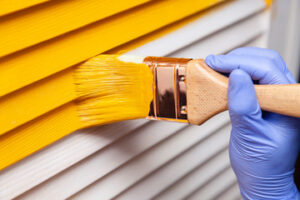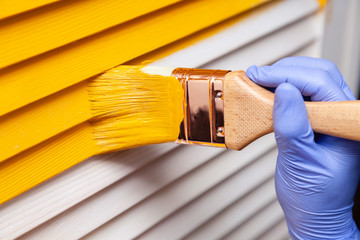Painting your home or business is a great way to increase its curb appeal and boost resale value. But which paint should you use for exterior painting?
Outdoor paint must be able to withstand winter’s cold and summer’s heat, as well as the constant forces of sunlight. It is also designed with additives to resist fading and other damage. Visit https://thompsonandboys.com/ to learn more.
Painting the outside of a building can be a huge undertaking. Having a team of experienced painters with the right tools is important to get the job done. A good paint job not only makes a home or business more attractive, it can also increase the value of a property.
The most important step in any painting project is preparing the surface. Paint does not adhere well to a dirty or rough surface. The surface needs to be thoroughly cleaned and primed to guarantee a quality paint job. If you skip this step, the paint will not last long, and it could start to chip or peel.
There are a few types of paint that can be used for exterior painting. These include acrylic-based, silicone, and grained paints. Silicone paints repel dirt, and grained paints contain ingredients that create a textured image. The type of paint that is best for the area will depend on weather conditions and how often the room is used. For example, a kitchen will need repainting more often than a bedroom, which is why selecting the proper color for each room is so important.
Unlike interior paint, exterior paint is designed to hold up against weather conditions. It is formulated with additives that help it resist fading, handle different temperatures, and avoid cracking. It is also made to be weatherproof, which means it will stand up to wind, rain, snow, and sleet.
Exterior paint is also formulated with binding resins to give it superior adhesion. This allows it to withstand changes in temperature and humidity, as well as resist damage from sunlight or other sources of UV rays. It can be combined with additives such as Outdoor Additive by Real Milk Paint to make it more durable for exterior use.
Primer
As the name suggests, primer is a base coat that helps prepare the surface for a top coat of paint. It helps the paint bond to a surface and also serves as a sealer for porous surfaces that can draw in paint and cause an uneven finish. Primers are especially important if you’re painting over bare wood or newly installed drywall.
There are a few different types of primers, each with its own purpose. Oil-based primers are typically used for exterior painting as they can withstand temperature changes while water-based primers are suitable for use on interior walls and furniture. Other additives in a primer can give it specific physical properties like stain blocking or water resistance.
If your home has mildew or mold on it, you’ll want to wash and scrub the area before you apply an anti-mold/mildew primer. Once the area is clean, you can lightly sand it to ensure the primer adheres well to the wall. It’s also wise to prime a moldy wall before you paint it to avoid future issues.
A good quality primer will also be formulated to prevent color fade, scrubbing and mildew. It can be tinted to match your new wall color, but don’t consider it a substitute for an additional coat of paint. You’ll need at least two coats of paint to cover the old wall color and the new primer.
While some paint-and-primer-in-one products are advertised as a solution to skipping the second coat, that’s usually not the case. A high-quality paint will not hide your walls in one coat, and a second coat is essential for a smooth, even finish.
If you’re working with a budget, it may make sense to purchase a primer in addition to your paint, since it will be cheaper than buying a separate gallon of each product. However, it’s best to purchase your paint in 5-gallon buckets whenever possible, as this will often save you money in the long run. Purchasing your paint in bulk also gives you access to a larger discount. Be sure to ask your local paint store for their best deals.
Paint
Painting exterior surfaces requires a special paint that stands up to varying weather conditions and protects the surface from debris. The best exterior paints contain additives that make them waterproof, able to withstand UV rays without fading, and abrasion-resistant to avoid chipping or peeling as twigs, leaves, and other items rub against the surface. The right residential exterior painters will be aware of the type of paint your home needs to stay safe and protected from the elements.
A fresh coat of paint does more than enhance curb appeal. It works as a barrier to keep out dirt, insects, and moisture that could damage or erode the wood that makes up the foundation of your home. It can also prevent mold and mildew from growing, which means a new coat of paint can save you from costly repairs in the future.
Interior paints do not have to deal with as many potentially harmful situations as exterior paints, so they don’t have the same additives to combat weather, temperature changes, and other factors that can affect their durability. Exterior paints need to hold up against all of this, so they have extra resins and additives that make them more durable and able to stand up to the harshness of outdoor environments.
In addition, exterior paints typically have a higher level of volatile organic compounds (VOCs), which can cause respiratory issues when inhaled. For this reason, many homeowners choose a low-VOC or zero-VOC paint to avoid these fumes.
As a general rule, oil-based paints have longer useful lives than water-based paints, but this is not always the case. A professional will know what type of paint is best for your home and will take into account the climate in your area, as this can impact how long your paint job lasts.
Finish
Unlike interior paints, exterior paint must be able to withstand harsh weather and debris. This is why it has extra additives that can resist fading, handle changing temperatures, and prevent cracking. It also has a higher level of water-resistance and mildew-resistance.
Choosing the right sheen can make or break your project. Flat paint has very little sheen and is great for hiding imperfections on walls, but it’s not something that should be used outdoors as it won’t hold up well to sunlight and rain. Eggshell has a nice, subtle sheen and is a popular option for exterior walls. Satin is a step up from eggshell, with even more sheen and durability.
High-quality exterior paints can last 20+ years, especially on aluminum and vinyl siding. However, they do need to be properly maintained and applied. To extend the life of your paint, it is recommended to clean it regularly with warm soapy water and a soft cloth or brush. It is also important to keep the area dry during painting, as moisture can cause the paint to sag or peel.
It’s also important to consider the climate in your area when selecting a sheen. For example, very low or extremely hot temperatures can affect the consistency of the paint and cause it to crack or flake. For this reason, we recommend working with a professional that is familiar with the local weather conditions and will be able to provide you with an accurate estimate for your project.
Deciding how many finish coats to apply depends on the condition of the home, the type of paint, and the skill of the painters. It is important to note that over-applying coats will increase the cost of your project without delivering any additional benefits. For this reason, it’s a good idea to consult with an experienced painter before applying any additional coats.
When choosing a residential exterior painter, it is important to review their previous work and customer reviews. You should also check that they have the proper licensing and insurance to perform work on your home. Lastly, be sure to request an upfront quote to ensure that you’re not overpaying for your paint job.

